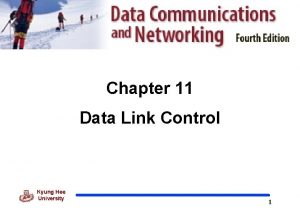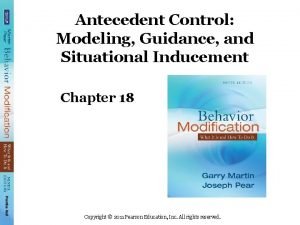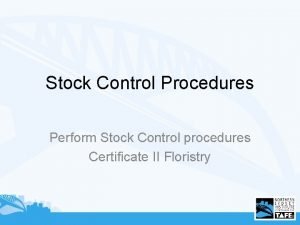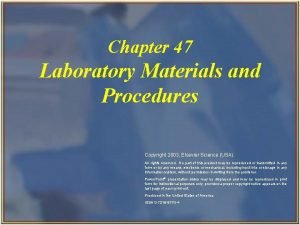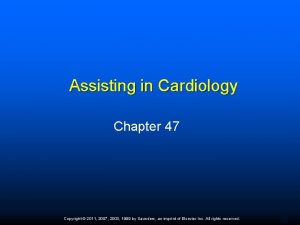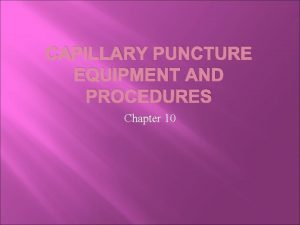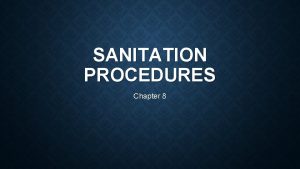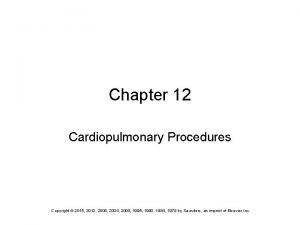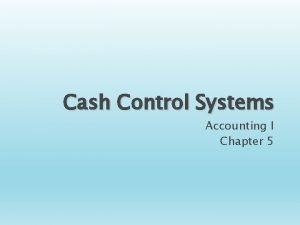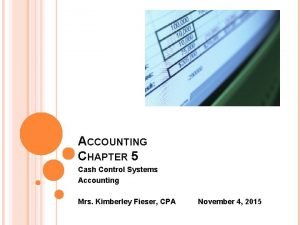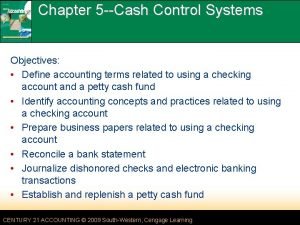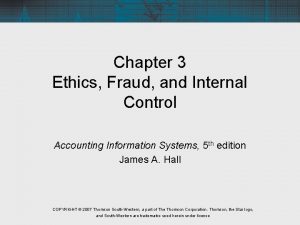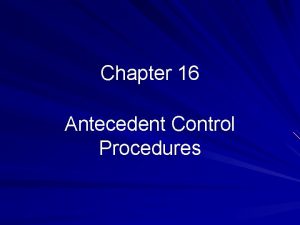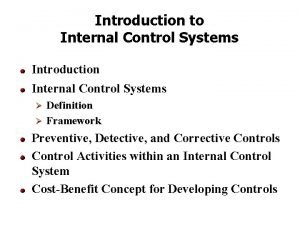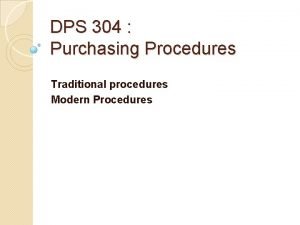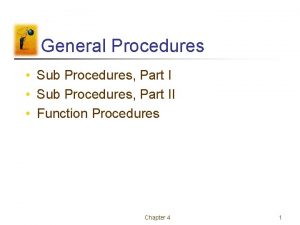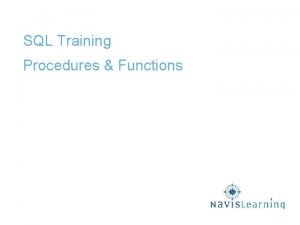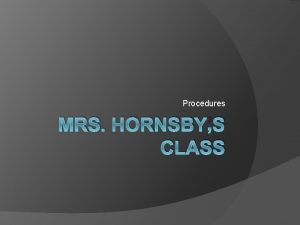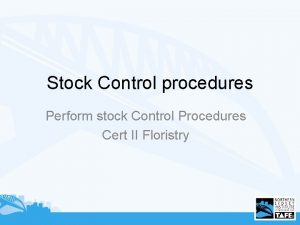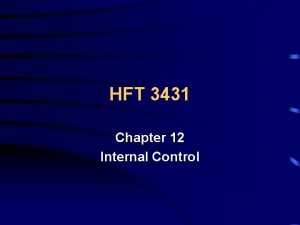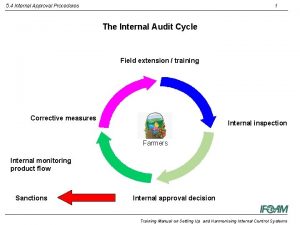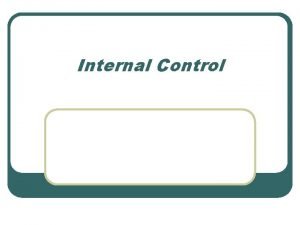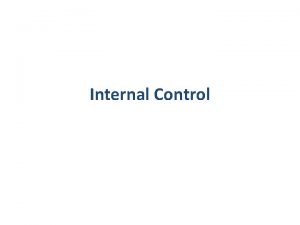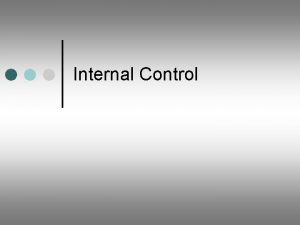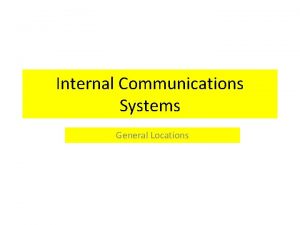Internal Control Procedures Chapter 3 Internal Control Systems



















- Slides: 19

Internal Control Procedures Chapter 3: Internal Control Systems

Accounting Subsystems In an Accounting System you will find many subsystems, such as accounts payable, accounts receivable, payroll, inventory, to name a few. Easier to divide an accounting system up into smaller parts and design specific controls for those subsystems.

Subsystem and Transaction Cycle Analysis Subsystem approach is based around Balance Sheet grouping of accounts. Another approach is to base it on the transaction cycle analysis – base it on the revenue cycle or the expenditure cycle. This is called the cycle approach.

Subsystem and Transaction Cycle Analysis The two approaches are not exclusive and overlap each other. It’s not just the subsystem or the transaction cycle that is the focus – it’s the internal controls within the subsystem and the transaction cycle.

Limitations of Internal Control General Accounting Controls Include: • Segregation of Duties • Proper authorisation procedures • Adequate documents and records • Physical controls to safeguard assets • Independent verification and reconciliations • Company practice and procedures manuals • Clearly defined lines of authority and responsibility

Limitations of Internal Control Smaller entities who have fewer employees may find it hard to implement some of these general accounting controls such as segregation of duties.

Inherent Limitations Even in the best designed and operated system there is still a chance of inadvertent errors (genuine mistakes) and intentional fraud (collusion). Control Risk can never be zero.

Inherent Limitations in controls need to be identified; these can be due to: • Human Error • Collusion between employees • Management override of controls • Operational changes • Unusual transactions • Lack of continuity • Errors • Fraud

Fraud Definition Fraud is any unlawful act of deception made for personal gain at the expense of another individual. In a corporate environment this usually involves a misappropriation of company assets by means of deliberate misrepresentation, concealment, embezzlement or extortion.

Difference Between Fraud and Error The term “error” refers to an unintentional misstatement in the financial report. The term “fraud” refers to an intentional act by one or more individuals involving the use of deception to obtain an unjust or illegal advantage.

Fraud – Who and Why According to KPMG’s 2010 Fraud and Misconduct Survey, of internal frauds approximately: • 10% were committed by senior executives or directors • 30% were committed by management • 60% were committed by employees In any fraud there are usually 3 factors present: • Motivation – pressure or incentive to commit the fraud • Opportunity – usually due to poor internal controls • Rationalisation – the person’s ability to accept the risk committing the fraud

Internal Control and Fraud An auditor should: • Be aware of the weaknesses in the internal control system, • Knows the general attitudes and morale within the organisation and the moral standards of the community, and • Be aware of the temptations, i. e. loopholes in the internal control system, can go a long way towards control of errors and fraud.

Some Types of Error and Fraud • • • False representations or concealment of facts Use of property for personal gain. Bribery Collusion Management fraud

Accounting Error and Fraud In the accounting system these types of errors and fraud may manifest as: • Erroneously recorded transactions. • Invalidly recorded transactions. • Unrecorded transactions. • Improperly valued transactions. • Ownership misstatements. • Transactions recorded in wrong period. • Improperly classified and calculated transactions.

Examples of Fraud Specific examples of fraud include: • Use of corporate credit card for personal expenses • Claiming “reimbursement” of expenses which were never incurred/paid • Stealing cash or inventory • Supplying false invoices • Resubmitting invoices • Setting up false employees on the payroll

Detection of Fraud • Standard systems and procedures – improper actions are recognisable • Persistence with unexplained errors, discrepancies and omissions • Ask open-minded questions • Be alert to false documents • Be alert to unusual employee behaviour – such as refusal to take holidays • Develop a memory for information and association

Deterring Fraud Adequate system of internal control will include the following procedures: • Analytical review procedures. • Segregation of duties. • Adequate authorisation procedures and independent checks. • Spot checks by management. • Good staff recruitment procedures. • Established system of disciplinary action for wrongdoers • Regular internal audits.

Fraud Prevention • • Conduct a risk assessment Enforce an ethical work culture Ensure senior management engagement Set up ethical hotlines/whistleblower facilitation Provide staff training/updates Ensure segregation of duties Have regular auditing and monitoring Perform rigorous employee due diligence

Indicators of Possible Fraud • Discrepancies in the accounting records. • Conflicting or missing evidence. • Problematic or unusual relationships between the auditor and management.
 System of internal controls
System of internal controls Vouching in auditing
Vouching in auditing Piggybacking in go-back-n arq
Piggybacking in go-back-n arq Antecedent control procedures
Antecedent control procedures Stock control procedures
Stock control procedures Chapter 47 laboratory materials and procedures
Chapter 47 laboratory materials and procedures Chapter 15 diagnostic procedures and pharmacology
Chapter 15 diagnostic procedures and pharmacology Chapter 12 banking procedures and services
Chapter 12 banking procedures and services Chapter 10 workplace safety procedures
Chapter 10 workplace safety procedures Cardiology procedures chapter 47
Cardiology procedures chapter 47 Puncture equipment
Puncture equipment Chapter 8 sanitation procedures
Chapter 8 sanitation procedures Chapter 12 cardiopulmonary procedures
Chapter 12 cardiopulmonary procedures Endorsement
Endorsement Received bank statement showing service charge
Received bank statement showing service charge Part six recording bank and petty cash transactions answers
Part six recording bank and petty cash transactions answers Cash control systems
Cash control systems Ethics and internal controls in accounting
Ethics and internal controls in accounting Controlsbond
Controlsbond Chapter 7 fraud internal control and cash
Chapter 7 fraud internal control and cash


